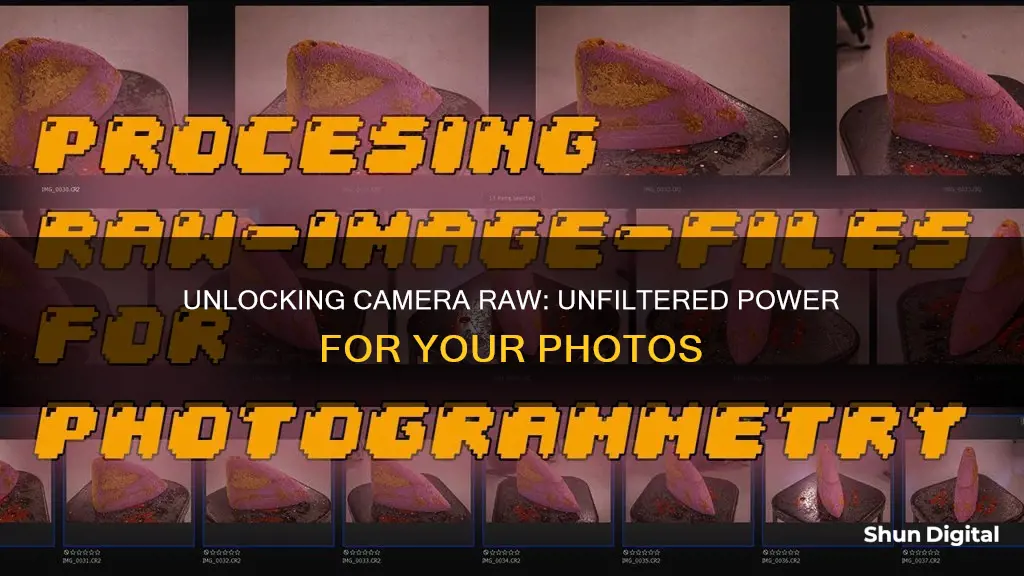
Camera Raw is a piece of software included in Adobe Photoshop that allows you to edit photographs in a non-destructive way. It makes those edits in a non-destructive way, meaning it's easy to reverse the changes and your original files are not changed in any way.
You can use Camera Raw to crop, sharpen photos, set white balance, adjust contrast, colour and tonal range, and more.
| Characteristics | Values |
|---|---|
| File type | Uncompressed and unprocessed image data |
| File size | Larger than other formats |
| Image detail | Higher than other formats |
| Lossless compression | Yes |
| Control | Greater than other formats |
| Compatibility | Not standardised, so some software can't read certain camera files |
| Processing time | Longer than other formats |
| Sharing | Need to be converted before sharing |
What You'll Learn

RAW files are uncompressed and unprocessed image data
When you take a photo in JPEG format, the camera automatically processes the image and makes adjustments to the light, colour, and sharpness. This means that the image is ready to be shared straight away, but it also means that you have less control over the final image.
With a RAW file, on the other hand, you get to make all of the adjustments yourself. This gives you much more control over the final image, as you can edit the white balance, exposure, shadows, highlights, and colours to create the exact image you want. You can also recover details that might have been lost in a JPEG image, such as a blown-out sky or underexposed shadows.
Another benefit of shooting in RAW is that you can make these adjustments without permanently changing the original file. This is known as non-destructive editing and means that you can always go back to the original image if you want to.
However, there are also some downsides to shooting in RAW. The larger file size means that RAW files take up more space on your memory card and hard drive, and they also take longer to process, which can be an issue if you need to deliver photos to a client quickly.
Overall, shooting in RAW gives photographers much more flexibility and control over their images, but it does require more time and storage space.
Starlink's Camera: Tesla's Battery Power Source?
You may want to see also

They are the highest-quality files available
Camera raw image files are the highest-quality files available. They contain unprocessed or minimally processed data from the image sensor of a digital camera, motion picture film scanner, or other image scanner. They are often referred to as "digital negatives" as they are the raw "ingredients" of a photo that will need to be processed to bring out the picture's full potential.
Raw files contain uncompressed and unprocessed image data, allowing photographers to capture practically every detail they see in their viewfinder. They store the largest amount of detail out of any raster file type, which photographers can then edit, compress, and convert into other formats.
The main advantage of shooting in raw is that it gives photographers more information to work with in the post-processing phase. Raw files contain a wider dynamic range or colour gamut than processed images, and they preserve all the information captured at the time of exposure. This means that photographers can capture a lot more detail, resulting in a greater colour range and depth to create vibrant images.
Another benefit of shooting in raw is the ability to recover shadows and highlights in post-processing without bringing in the grainy noise usually associated with high ISO settings. Raw files are very forgiving if you have severely underexposed or overexposed areas.
However, it's important to note that raw files are much larger than other file formats, such as JPEG, and require additional storage space. They also require more work in the editing stage, as the photographer has full control over the processing of the image.
Olympus Pen Camera Battery: Charging Time Explained
You may want to see also

They are often referred to as digital negatives
RAW image files are often referred to as digital negatives because they are the raw "ingredients" of a photo. They are uncompressed and unprocessed image data captured by a camera or scanner's sensors. This means that they contain the most detail compared to other raster and vector file types, giving photographers a lot more to work with when editing photos.
When a photo is taken with a camera's native app, the image is processed before it can be viewed. The light hitting the sensor, collected as 0s and 1s, is turned into an image. This processing also enhances the image, making it look vibrant and sharp, like in real life. However, a RAW image file skips this processing and contains more of the data captured by the sensor. This gives photographers full control over processing the image themselves.
Because RAW files are uncompressed, they are much larger than compressed file formats like JPEGs. They also require more storage space, both on the camera and during post-processing. Despite these drawbacks, most professional photographers shoot in RAW because it gives them more information and control during the post-processing phase. With a RAW image, photographers can make any kind of adjustment, such as converting a black-and-white image to colour, without changing the original RAW image itself.
RAW files are considered the highest-quality files available for shooting and saving due to their high level of detail and lack of compression or conversion, which can lower image quality. This high quality results in larger file sizes, but it also means that RAW files are very forgiving if you have severely underexposed or overexposed areas in your image. With a RAW file, you can recover shadows and highlights in post-processing without the grainy noise usually associated with high ISO settings.
Cleaning Camera Batteries: A Step-by-Step Guide
You may want to see also

They are editable in non-destructive photo-editing software
RAW image files are unprocessed and uncompressed image data captured by a camera's sensor. They are often referred to as digital negatives, containing the raw "ingredients" of a photo that will need to be processed using photo-editing software.
Non-destructive photo-editing software allows photographers to edit their RAW image files without permanently changing the original data. This means that edits are saved separately from the original file, so photographers can always revert to the original image if needed. This is particularly useful when working with RAW files, as it allows photographers to experiment with different edits and adjustments without losing the original image data.
Some popular non-destructive photo-editing software packages include Adobe Lightroom, Adobe Lightroom Classic, Adobe Photoshop, Adobe Photoshop Elements, Capture One Pro, CyberLink PhotoDirector, and Corel PaintShop Pro. These programs offer a range of editing tools and features, such as noise reduction, lens correction, and local adjustment tools, while preserving the original RAW file.
Using non-destructive editing software, photographers can make a wide range of adjustments to their RAW images, including exposure, white balance, color balance, dynamic range, colors, noise, contrast, saturation, and sharpening. They can also recover shadows and highlights, apply presets and effects, and perform advanced color grading.
By utilizing non-destructive photo-editing software, photographers can take full advantage of the flexibility and editing capabilities offered by RAW image files, while always having the option to revert to the original image data if needed. This approach empowers photographers to experiment and make extensive adjustments to their images with confidence, knowing that their original capture remains intact.
Charging Your SQ11 Camera: How Long Does It Take?
You may want to see also

They are larger in size than JPEG files
RAW files are uncompressed and unprocessed image files that contain all the data captured by a camera's sensor. They are often referred to as "digital negatives" because they are the raw "ingredients" of a photo that will need to be processed to bring out the picture's full potential.
RAW files are significantly larger in size than JPEG files. This is because they are uncompressed and contain all the data from the camera sensor. A 16-megapixel camera, for example, will produce a 16 MB RAW file. In comparison, a JPEG file of the same size will only use around 5 MB of space. This means that RAW files can take up 3-4 times as much space as JPEG files, and you will be able to fit almost five JPEGs in the area of one RAW file.
The large size of RAW files can be a disadvantage as it requires more storage space. This can be a problem for photographers who need to store many images and can quickly fill up their memory cards and camera buffers. Additionally, the larger file sizes can lead to longer backup procedures and workflows, as well as sharing restrictions.
Despite the larger size, many professional photographers still choose to shoot in RAW because it gives them more information and control to work with during post-processing. RAW files offer greater flexibility and allow for non-destructive editing, meaning that adjustments can be made without altering the original data. This gives photographers the ability to correct mistakes and experiment with different edits without permanently changing the original image.
Polaroid Camera Battery Guide: Which Batteries to Use?
You may want to see also
Frequently asked questions
A RAW file is an uncompressed and unprocessed image file that contains the most amount of detail out of any raster file type. It is essentially a digital negative that can be edited, compressed, and converted into other formats.
A JPEG file is a compressed version of a RAW file. It is automatically processed in the camera and is smaller in size, making it easier to share. However, a RAW file provides more flexibility and control during post-processing as it contains more data.
Shooting in RAW allows for greater control over the final image as it captures a high level of image detail. It offers a wider colour range, lossless compression, and the ability to make adjustments without changing the original RAW image.
To open a RAW file, you need image editing software such as Adobe Photoshop, Lightroom, or Camera Raw. These programs allow you to make quick and powerful edits to your photographs in a non-destructive way, meaning you can easily reverse changes without altering the original file.







